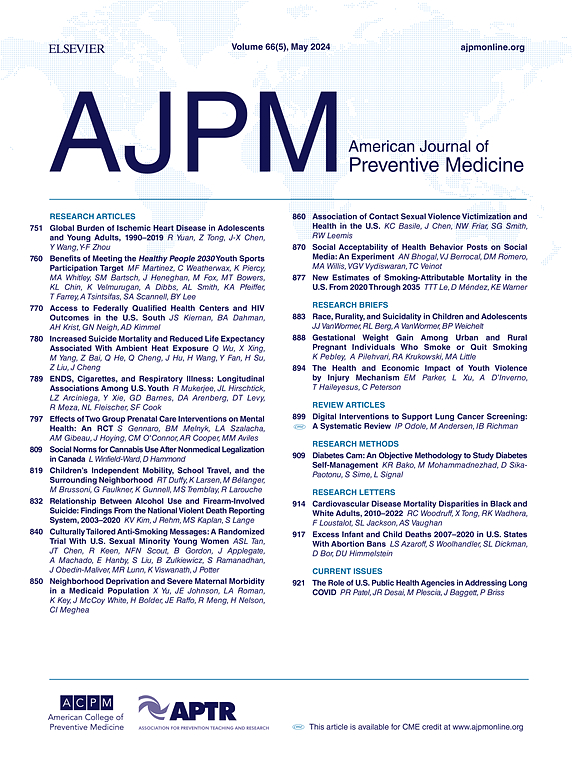美国枪支拥有者中与安全枪支储存相关的因素
IF 4.3
2区 医学
Q1 MEDICINE, GENERAL & INTERNAL
引用次数: 0
摘要
本研究通过直接和间接措施调查了安全枪支储存行为的流行程度,确定了相关因素,并为有针对性的公共卫生干预提供了见解,以减少枪支伤害。方法在2024年1月进行了一项针对10,000名美国成年人的在线横断面调查。受访者自我报告的枪支所有权和储存实践是直接衡量的(上锁和卸载)和间接衡量的(如果你在半夜需要你的枪支,你大约需要多长时间才能准备好使用它?)多变量逻辑回归模型确定了安全存储的人口统计学、社会经济和枪支相关的相关性。大约一半的枪支拥有者报告说他们的枪支是锁着的,而且没有上膛,而三分之二的人报告说他们在60秒内就能拿到枪支。安全储存在女性、家中有孩子的个人、拥有较少枪支的人以及主要使用枪支用于狩猎、运动或收藏的人中更为常见。不安全存储在受访者中更为普遍,他们表示害怕在各种情况下被枪击,包括在家里、在社区或在工作中。某些人口统计和背景因素,特别是受害历史、政治倾向和儿童访问预防法的存在,根据一种衡量标准与安全存储有关,但根据另一种衡量标准则与安全存储无关,这突出了如何衡量这些做法的差异。枪支储存行为在很大程度上是由安全观念驱动的,这突出了公共卫生工作的必要性,以消除恐惧,并为不太可能安全储存枪支的群体量身定制信息。本文章由计算机程序翻译,如有差异,请以英文原文为准。
Factors Associated With Secure Firearm Storage Among U.S. Gun Owners
Introduction
This study examines the prevalence of secure firearm storage behaviors through direct and indirect measures, identifies associated factors, and provides insights for targeted public health interventions to reduce gun injury.
Methods
A cross-sectional survey of 10,000 respondents designed to be representative of U.S. adults was administered online in January 2024. Respondents self-reported firearm ownership and storage practices measured directly (locked and unloaded) and indirectly (If you need your firearm in the middle of the night, approximately how long would it take you to have it ready to use?). Multivariable logistic regression models determined demographic, socio-economic, and firearm-related correlates of secure storage.
Results
Approximately half of gun owners reported storing their firearms locked and unloaded, while two thirds reported having access in under 60 seconds. Secure storage was more common among women, individuals with children in the home, those who owned fewer firearms, and those whose primary firearm use was for hunting, sport, or collection. Unsecure storage was more prevalent among respondents who reported fears of being shot in various contexts, including at home, in their neighborhood, or at work. Certain demographic and contextual factors, notably, victimization history, political orientation, and the presence of child access prevention laws, were associated with secure storage according to one measure but not the other, highlighting differences in how these practices are measured.
Conclusions
Firearm storage behaviors are largely driven by perceptions of safety, highlighting the need for public health efforts that address fear and tailor messaging to groups less likely to store firearms securely.
求助全文
通过发布文献求助,成功后即可免费获取论文全文。
去求助
来源期刊

American Journal of Preventive Medicine
医学-公共卫生、环境卫生与职业卫生
CiteScore
8.60
自引率
1.80%
发文量
395
审稿时长
32 days
期刊介绍:
The American Journal of Preventive Medicine is the official journal of the American College of Preventive Medicine and the Association for Prevention Teaching and Research. It publishes articles in the areas of prevention research, teaching, practice and policy. Original research is published on interventions aimed at the prevention of chronic and acute disease and the promotion of individual and community health.
Of particular emphasis are papers that address the primary and secondary prevention of important clinical, behavioral and public health issues such as injury and violence, infectious disease, women''s health, smoking, sedentary behaviors and physical activity, nutrition, diabetes, obesity, and substance use disorders. Papers also address educational initiatives aimed at improving the ability of health professionals to provide effective clinical prevention and public health services. Papers on health services research pertinent to prevention and public health are also published. The journal also publishes official policy statements from the two co-sponsoring organizations, review articles, media reviews, and editorials. Finally, the journal periodically publishes supplements and special theme issues devoted to areas of current interest to the prevention community.
 求助内容:
求助内容: 应助结果提醒方式:
应助结果提醒方式:


